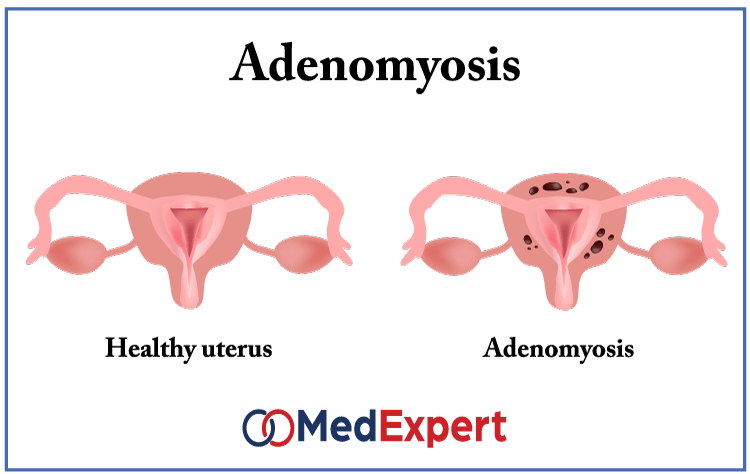ADENOMYOSIS
Many women after 30 years old are diagnosed with adenomyosis. Causes of this disease include all factors linked to breach of barrier between endometrium and womb muscle layer. Adenomyosis treatment may consist of conservative or surgical options depending on the patient`s age. We will discuss the nature of this disorder, as well as treatment options and adenomyosis diagnosis methods in detail below.
This is a condition where the inner lining of the uterus (endometrium) breaks through the muscle wall of the uterus (myometrium). This disease can cause symptoms such as menstrual cramps, lower abdominal pressure and bloating before menstrual periods which can result to heavy periods. This condition can occur either throughout the uterus or can be localized in one spot. This disorder is not considered to be a life threatening condition but the symptoms caused can lead to negative impacts on a woman’s quality life.

Adenomyosis is a common condition which is mostly diagnosed in middle aged women who have conceived children. Studies also suggest that women who have had past uterine surgery may be at risk for this disease.
CAUSES OF ADENOMYOSIS
Although the cause of this disorder is not known, studies made suggest various hormones such as estrogen, progesterone, prolactin and follicle stimulating hormone may prompt the condition. Theories have also been made about possible causes of adenomyosis, they include:
- Invasive tissue growth: This theory suggests that a direct invasion of endometrial cells from the lining of the uterus into the muscle that forms the uterine walls may be a cause of adenomyosis. An operation such as uterine incisions made during caesarean section is suggested.
- Developmental origins: Some experts believe that this disease develops within the uterine muscle from an endometrial tissue deposited when the uterus was first formed in the foetus.
- Uterine inflammation related to child birth: This theory suggest a link between this condition and childbirth whereby an inflammation of the uterine lining during the postpartum period of childbirth might cause a break in the normal boundary cells that line the uterus.
- Stem cell origins: This theory suggests that adenomyosis is caused by the invasion of bone marrow stem cells In the uterine muscle.
Irrespective of the cause and development of this condition, the growth depends on the circulating estrogen in a woman’s body.
DOES ADENOMYOSIS CAUSE INFERTILITY?
Women who have this disease have been known to also have endometriosis making it difficult to tell the role of adenomyosis in infertility problems. However, studies have shown that adenomyosis may be a cause of infertility.
SYMPTOMS OF ADENOMYOSIS
Symptoms of adenomyosis include:
- Heavy or prolonged menstrual bleeding.
- Severe cramping or sharp pelvic pain during menstruation.
- Menstrual cramps that last through periods and increase as age increases.
- Painful intercourse.
- Blood clots that pass during periods.
- Increased abdomen or uterus size.
ADENOMYOSIS TREATMENT OPTIONS
Treatment for adenomyosis depends on how close menopausal stage is in a woman, treatment options include:
- Anti-inflammatory drugs: Doctors may recommend anti-inflammatory drug like Ibuprofen when one is nearing menopause to control the bleeding and pain. The medication should start two or three days before the start of period and during the period.
- Hormone medication: Heavy bleeding and pain associated with adenomyosis may be lessened through the use of combined estrogin-progestin birth control pills or hormone containing patches or vaginal rings.
- Hysterectomy: Surgery is suggested if the menopausal stage is years away and the pain is severe. This procedure involves the removal of the uterus, removal of the ovaries is not necessary.
- Uterine artery embolization: This is a technique used to help shrink fibroids, it is a minimally invasive procedure in which tiny particle are used to block vessels that provide blood flow to this disease. This procedure shrinks it.
- Endometrial ablation: This procedure destroys the lining of the uterus and is best used when this disorder has not deeply penetrated into the muscle wall of the uterus.
ADENOMYOSIS DIAGNOSIS
- History taking: The doctor asks for a description of the symptoms occurring, location of the pain and when it happens. Questions about the family and menstrual periods are also asked.
- Pelvic exam: The doctor feels the area of the pelvis for the occurrence of abnormalities such as cysts on the reproductive organs or scars behind the uterus. Small areas of endometriosis may not be felt unless there is a formation of cysts.
- Ultrasound: This test makes use of high frequency sound waves to create images of the internal body. To create the images of the reproductive organs, a device known as the transducer is either pressed against the abdominal skin or inserted into the vagina. Ultrasound imaging provides the best view of the reproductive organs.
- Magnetic Resonance Imaging (MRI): This is used for confirmation of adenomyosis in women.


